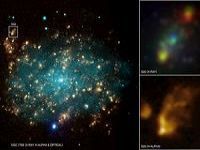Astronomy Event discusses the origin of the universe
Duília de Mello, Brazilian researcher at NASA, will talk about blue bubbles, isolated stars outside of galaxies
by Luisa Girão, iG
 Rio is again the scene of debates on the latest discoveries in astronomy from the workshop of the series "The Evolving Universe", PUC-Rio, that from 15-19 August will feature more than 40 lectures by researchers from South America, the U.S. and Europe. The event was conceived by Duília de Mello, an associate researcher at NASA Goddard Space Flight Center and professor at the Catholic University of America, with the professor, Enio Frota da Silveira, of the physics department of the Scientific Technical Center of PUC.
Rio is again the scene of debates on the latest discoveries in astronomy from the workshop of the series "The Evolving Universe", PUC-Rio, that from 15-19 August will feature more than 40 lectures by researchers from South America, the U.S. and Europe. The event was conceived by Duília de Mello, an associate researcher at NASA Goddard Space Flight Center and professor at the Catholic University of America, with the professor, Enio Frota da Silveira, of the physics department of the Scientific Technical Center of PUC.
"In addition to presenting what is being produced in the area we want to create a greater connection between the students of astronomy of the various entities and an interaction between these colleges," says Duília. The lectures will cover the issue of chemical evolution, galaxies, the Milky Way, the evolution of galaxies, stellar evolution, black holes, cosmic rays in distant galaxies and the formation of the Milky Way.
Duília gave a free lecture open to the public on Tuesday (16th), 20.30, at Gávea Planetarium, with the theme, "From Big Bang to Humans," where she summarized the history of the universe and talked about their latest discovery: blue bubbles - single stars outside of galaxies.
In 2008, after using a NASA satellite - which only detects ultraviolet light - and making a deeper analysis of the Hubble telescope, Duília realized that the bubbles were formed by very young blue stars. "When galaxies pass close to each other, they leave gas in the neighborhood and promote the formation of these blue stars," she explains, who specializes in extragalactic astronomy.
NASA: childhood dream
It was through work with the Hubble Space Telescope, that the astronomer was called to work at the U.S. space agency in March 2003. "In 1997 I worked at the Hublle Space Telescope Institute in the United States. In 2000, I was called to be a teacher assistant at Onsala Observatory, Sweden.
I accepted the offer, but after two years, wanted to move back to the United States and started sending emails from my contacts. It was here that the opportunity arose at NASA. "A childhood dream," recalls Duília, who was also responsible for the discovery of supernova SN1997D in 1997 in Chile.
Even accounting for significant discoveries and working in the main space agency, Duília keeps her feet on the ground. "I'm not the first Brazilian to work for NASA. At the Goddard Space Center, for example, there are six Brazilians. I'm not treated differently from the many other researchers working there," she says.
Space-shuttle
The astronomer also talked about the process of readjustment, with NASA retiring its space-shuttle program, with which, for 30 years, it carried out manned flights to space. "It's a serious problem because NASA has no substitute, while Russia has one developed already."
"But there is a plan in the long term, reshaping in order to do and even more distant flights until we land on asteroids," she argues, adding: "NASA has two manned space flight projects. One to the Moon and one for Mars. Initially, we talked about this happening between the years 2020 and 2037. But with the current situation, there is more uncertainty."
Translated from the Portuguese version by:
Lisa Karpova
Pravda.Ru
Subscribe to Pravda.Ru Telegram channel, Facebook, RSS!





